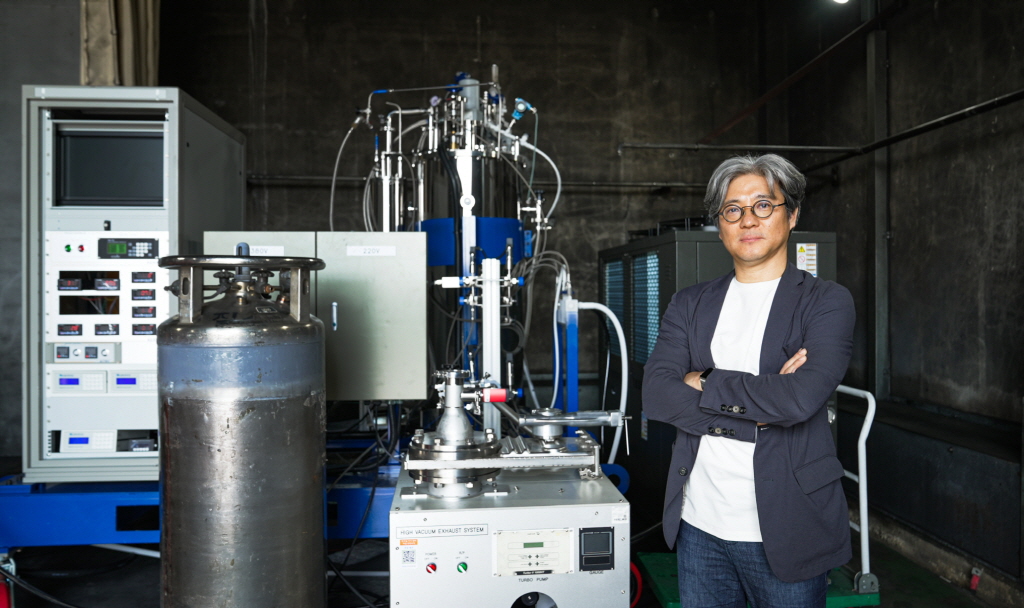한국전기연구원(KERI)이 액체수소의 생산과 안전밸브의 성능 평가까지 한 번에 수행할 수 있는 장치를 세계최초로 개발하며, 국내 액체수소 보급 및 안전에 크게 기여할 것으로 기대된다.

▲KERI 고락길 팀장이 ‘액체수소용 안전밸브 성능 평가 장치’와 함께 기념촬영을 하고 있다.
전기연, 액체수소용 안전밸브 성능 평가 장치 개발
이동형 장치 좁은 공간에서도 쉽고 편리하게 운용
한국전기연구원(KERI)이 액체수소의 생산과 안전밸브의 성능 평가까지 한 번에 수행할 수 있는 장치를 세계최초로 개발하며, 국내 액체수소 보급 및 안전에 크게 기여할 것으로 기대된다.
전기연구원은 최근 수소전기연구팀이 액체수소 생산부터 안전밸브 성능 평가까지 모두 수행할 수 있는 획기적인 장치를 개발했다고 31일 밝혔다. 산업부가 수소경제 활성화를 위해 지정한 ‘수소의 날(수소의 원소 기호인 H2를 이미지화해 11월2일로 지정)’을 앞두고 나온 의미 있는 성과라 업계의 큰 관심을 받을 것으로 보고 있다.
액체수소는 수소가스를 아주 낮은(-253도) 온도로 냉각해 액화한 것으로, 부피는 기체 형태 대비 무려 800배나 작아 보관 위험성이 낮고, 주민 수용성 확보에 용이하다.
운송 개념에서도 기존 가스를 옮기던 때보다 수소를 액체 형태로 훨씬 많은 양을 더욱 안전하게 옮길 수 있어, 전국적으로 수소의 보급을 크게 확산시킬 수 있다.
반면에 액체수소는 생산도 중요하지만, 장기 저장 및 이송 과정에서의 극저온 상태 유지, 수소탱크 내부 압력의 꾸준한 관리 등 기술적인 부분이 많이 필요하며, 관련 부품의 품질도 매우 중요하다.
그중에서도 안전밸브는 탱크 내부의 압력이 일정 수준 이상으로 올라가 위험이 발생하면, 수소를 고압의 기체 형태로 자동 방출하여 압력을 조절하는 중요 역할을 수행한다.
문제는 국내에 아직 액체수소의 생산·유통 네트워크가 완전히 구축되지 않은 상황에서 안전밸브 제조 기업만의 힘으로 제품의 품질을 완전히 검증하는 데는 한계가 있다는 것이다.
현재 액체수소의 확보가 어렵기 때문에 기업들은 어쩔 수 없이 액체수소보다 높은 온도의 액체질소나, 액체헬륨이라는 비싼 대체재를 이용해 부품의 성능을 불완전하게 검증할 수밖에 없었다.
실제 액체수소가 충분하게 보급되는 조건에서 제품 성능의 실증을 확실하게 거치지 못하고, 저품질의 안전밸브가 상용화된다면 추후 큰 사고로 이어질 수 있다.
이에 KERI는 액체수소 생산부터 안전밸브 성능 평가까지 모두 수행할 수 있는 획기적인 장치를 개발했다.
장치 하나만 있으면 실제 액체수소를 생산하고, 바로 부품의 성능까지 평가할 수 있는 간편한 시스템을 구축한 것이다.
연구원은 이미 수년 전, ‘제로보일오프(Zero Boil-off)’라고 불리는 자동 극저온 냉각 기술을 통해 액체수소를 생산하고 장기 저장할 수 있는 국내 독보적인 기관으로 손꼽히고 있었다.
이후에도 수소 보급의 확대를 위해 다양한 노력을 기울였고, 기존 보유한 액체수소 기술력을 기반으로 안전밸브 품질 검증까지 연계하는 장치 개발에 성공한 것이다.
해당 장치는 3톤 규모의 액체수소 탱크 트레일러용 안전밸브의 성능을 평가할 수 있는 수준이며, 기업들이 쉽게 설치 및 운용할 수 있도록 이동형으로 제작됐다.
또한 국제공인 전력기기 시험인증기관인 KERI의 방폭시험동에서 장치의 안전성 검증도 확실하게 거쳤다.
KERI 고락길 수소전기연구팀장은 “국내는 물론, 해외에서조차도 실제 액체수소 환경에서 안전밸브 성능 평가를 제대로 진행하고 있지 않아 전문가들의 우려를 낳고 있다”며 “좁은 장소에서도 간편하고 안전하게 액체수소를 생산하고 안전밸브까지 한 번에 평가할 수 있는 우리의 개발 장치를 통해 국내 수소 산업의 경쟁력을 크게 높일 수 있을 것”이라고 전했다.
연구원은 추가적인 실험을 통해 더 큰 압력과 수소 규모를 감당할 수 있도록 개발 장치의 기능성을 높인다는 계획이다.
또한, 한국가스공사 등 공인 인증기관의 안전밸브 성능 평가에 장치가 활용될 수 있도록 필요한 요구사항을 적극 반영해 수용할 예정이다.
뿐만아니라 이번 성과가 액체수소 부품 업체 및 평가 장치 관련 기업들의 많은 관심을 받을 것으로 보고, 기술이전도 추진한다는 목표다.
한편 KERI는 과학기술정보통신부 국가과학기술연구회 산하 정부출연연구기관이다. 이번 연구는 산업부 및 한국에너지기술평가원의 ‘액체수소 운송을 위한 3,000kg 용량 탱크 트레일러 개발 및 실증 사업’ 과제를 통해 진행됐다.
